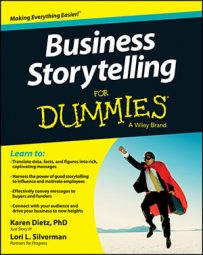No one can fight with a personal dream story you share about the future of a project, a business, a product or service, or an enterprise. It’s yours. You own it. However, they can always fight a future story that’s created by a group of people because they weren’t involved in creating it or it doesn’t jibe with what they think it should be.
How might you deal with this dilemma, especially because both dream and future stories help relay the vision of the change? Here’s what we’ve learned so far through our experiences with all types and sizes of organizations:
In organizations that employ small numbers of people, the founder may choose to share their dream for a change or have everyone collectively create the future story for the change. You could even do both!
In organizations where there are multiple partners (law firms, accounting and physician practices, and the like), it’s critically important that the principals discuss their individual dreams for a change. If they aren’t aligned, it may mean a partner needs to reconsider involvement with the firm.
This is one type of organization where a collective dream story works best to show unity. If the firm is small, a single future story of the change generated by employees is also useful. If there are multiple units, each unit will want to create its own future story based on this dream.
In organizations that have one site (or a large presence through a couple sites in a community or region) and a large staff, the most senior executive, in addition to all senior staff, need their own dream stories in an enterprise-wide change. It’s not important that these stories be identical. However, before deploying them, ensure dream story alignment, conceptually and philosophically.
Future stories need to be specific to each area of the organization. For example, in a hospital, the CEO’s dream may be about patient-centered delivery of care. Each group then creates a future story of what actualizing this dream would look like to it. Marketing’s future story would be specific to marketing. The operating room’s story is specific to it. Critical care has its own future story too.
Aligning these departmental future stories is key to alleviating potential conflicts and synergizing initiatives across groups.
In an organization-wide change within an enterprise with multiple sites scattered across a large geography, decide how localized the dream story needs to be to incite change.
Strengthen the dream story shared by corporate executives at these local sites by tailoring the message to the audience and having it shared at the same time that the local leader shares his dream story. Future stories need to be localized.
There are multiple considerations in membership organizations such as professional and trade associations, where there’s a paid staff and volunteer leadership changes every year or two. Staff and volunteer leadership need to be aligned in their dreams. A single, collaboratively developed dream story is key for the dream to last beyond anyone’s tenure, especially if the change is multi-year.
Individual chapters and special interest groups will want their own future stories. Remember that active volunteers are attracted to organizations where a dream’s been articulated and members and staff are bringing it into reality.
In government organizations, there are multiple constituents and stakeholders whose dreams and future stories need to be accessed. The leader’s dream for the change needs to be shaped by input from these various individuals and groups. Once that’s happened, different units can develop their individual future stories and rally behind the shared dream.
Here are three nuances that play into each of these situations:
Have employees write their own dream or future story of the change. Much of the energy invested in communicating is better spent listening, not telling, say Lawson and Price. They found when employees choose for themselves (autonomy), they’re more committed to the outcome by a factor of almost five to one.
Traditional approaches to enterprise and project-oriented change overlook this fact. Many leaders naively say, “Why not just tell them and be done with it?” This raises a critical question: If employees have no personal story to share about the change, how can they take ownership of it?
This example that Lawson and Price share has something to teach us. Prior to 2003, oil and gas company BP wanted to develop a training program for frontline leaders. A decision was made early on to involve every key constituent in the design of the program, allowing them to write their own ticket. It took 18 months to complete the process, but the results have been immense.
Now in implementation, 250 senior managers from across the organization willingly teach in it, and the program is the highest rated of its kind at BP. Attendees are consistently ranked higher in performance by their bosses and direct reports.
Have all staff participate in crafting the overall dream or future story. Here we can learn from the field of appreciative inquiry. Consider holding a series of gatherings where groups create their own dreams or future stories. These roll up from the grassroots and are aligned throughout the organization. Eventually, the collaboratively developed dream or story makes it way back down through the enterprise to all.
What to do when multiple visions need to be crafted. Sometimes a large change, such as implementing a new strategic plan, has multiple types of visions. There’s the vision of the change related to the plan’s overall impact on the organization. Then there are visions associated with each strategy (or goal or objective, depending on your organization’s nomenclature) that also need to be fleshed out.
In these situations, the overall vision should be driven by a dream and for each strategy to be guided by its own future story.

